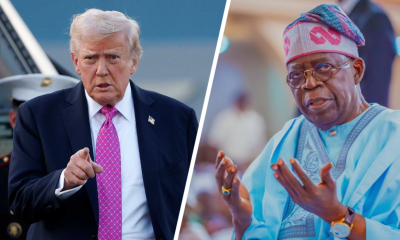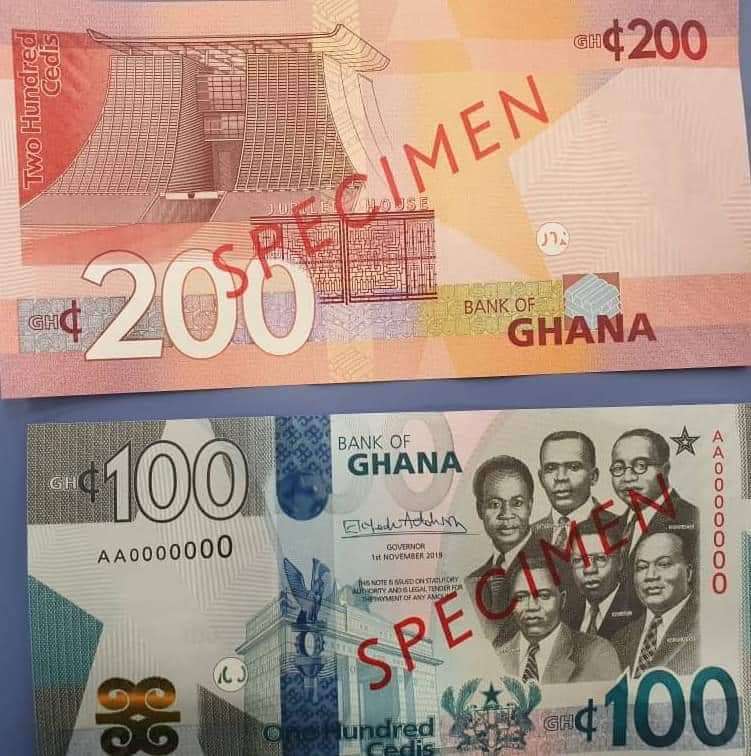The Governor of the central bank, Dr. Ernest Yedu Addison, has announced the introduction of GH¢100 and GH¢200 notes to the country’s currency denomination.
Also, GH¢2 coins have been introduced.
The new notes which go into circulation Friday were unveiled at a press conference at the Banking Hall of the Bank of Ghana (BoG).
“A lot of thinking went into the decision to introduce the higher denomination banknotes. The structure of the banknote should align well with the needs of the people who use it for their daily transactions.
“We need banknotes and coins that are convenient for most people to use, high quality, secure and cost-effective. Accordingly, in March 2017, the Bank of Ghana begun a process of conducting a thorough review of the structure of the currency including on the note/coin boundary and acceptability and use of the individual currency series,” Dr. Addison said.
He said the review exercise which involved conducting a nationwide survey with market operatives, businesses and international stakeholders as well as some empirical exercise.

News 200 and 100 GHC notes specimen
The Governor added that “the outcome of these exercises revealed the resurgence of deadweight burden issues on the economy due to past significant inflation and perennial depreciation of the currency, a significant increase in the demand for higher denomination banknote and increased the cost of printing.”
Dr. Addison said in line with the results of the exercise, the BoG is introducing the new notes to complement the existing series to ensure customer convenience and bring about efficiency in the printing of currency to generate savings for the country.

News 2 GHC coin specimen
“These new higher value denominations will only restore partially the dollar value of the higher denomination GH¢200 to about US$40, not quite close to levels in 2007, but high enough to significantly reduce the deadweight burden and high transaction cost in making high-value purchases in a cash-based economy like Ghana,” he said.
In May this year, BoG put into circulation, upgraded banknotes of the Ghana Cedi. The rationale for upgrading the banknotes was primarily to enhance the security features of the banknotes in the context of an evolving technological landscape and to bring on board features that will secure the currency and make it difficult for counterfeiting.
In addition to enhancing the security features, the upgraded banknotes came with specific features to improve durability and enhance their machine readability.

News 200 and 100 GHC notes specimen
The upgrade exercise retained the design features of the existing series of banknotes and coins as introduced 12 years ago in 2007, in a redenomination exercise that sought to recalibrate the currency due to a significant deadweight burden which was a legacy of long periods of high inflation and currency devaluation.

News 200 and 100 GHC notes specimen
Dr. Addison explained that the “redenomination exercise aimed to eliminate four zeros from the existing unit of currencies in an attempt to introduce efficiency in the economy and remove the dead-weight burden on the economy associated with transactions. At the time of the redenomination, GH¢1 was equivalent to US$1.
“The highest denomination then was GH¢50 and was equivalent to the US$50. Twelve years after the redenomination exercise, sustained periods of high inflation and the perennial depreciation of the currency have eroded, in real terms, the face value of the series of the notes.”
The Governor said the introduction of the high-value notes should not be misinterpreted to mean a shift away from the Central Banks policy of pursuing a cashless society and promoting the use of electronic modes of payments.
“While vigorously pursuing financial inclusion by accelerating the migration to e-payment platforms, we are also mindful of the relevance of cash in our day-to-day dealings. Undeniably, cash still remains the preferred medium of payment by the large informal sector in the country.
“This is why we continue to pay attention to enhancements in the structure, security features and management of cash within the economy. This will stay with us for some time,” Dr Addison said.
He also disclosed that the Bank of Ghana will embark on a nationwide campaign to educate the general public on the new denominations.
“I entreat every Ghanaian to study these new denominations carefully and be familiar with the main features to facilitate the detection of fake currency notes.
“The need to properly handle our banknotes is still of significant importance and we must strive to keep them clean at all times in line with the Bank’s Clean Note Policy. In other words, ‘Know the cedi Cedi and Keep it clean,’” he said.

 Entertainment3 months ago
Entertainment3 months ago
 Celeb Gossip3 months ago
Celeb Gossip3 months ago
 News3 months ago
News3 months ago
 News3 months ago
News3 months ago
 World News2 months ago
World News2 months ago
 News1 month ago
News1 month ago
 World News1 month ago
World News1 month ago
 News1 month ago
News1 month ago









